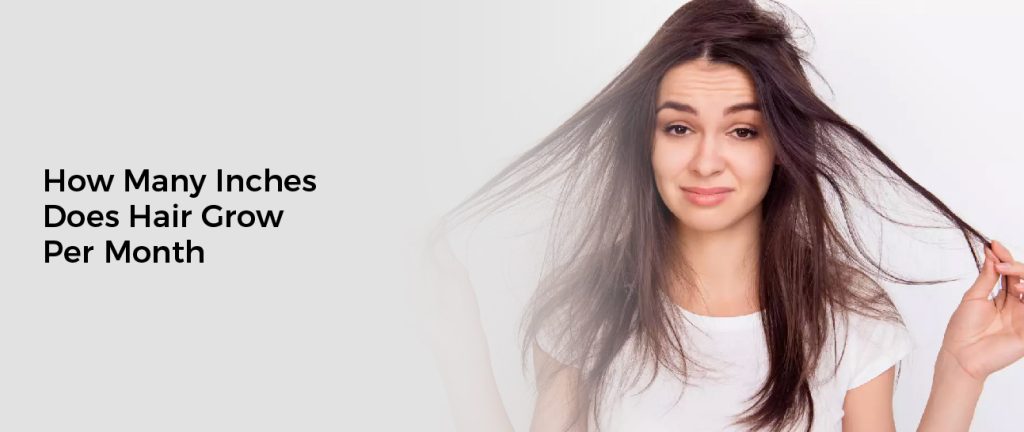Everyone has experienced the agonizing wait for their hair to grow. We’re all eagerly watching and hoping each time we glance in the mirror that our split ends have gotten a little bit longer – but how much does hair grow in a month? For those looking to keep track of our progress, it’s essential to understand just how fast your locks can lengthen. Knowing this information will help you decide if cutting off those dead ends is necessary or if waiting may lead to better results than expected. So let’s dig into this question and find out: How many inches does hair grow per month?
How Fast Does Hair Grow in Inches in a Month?
The average rate of hair growth is about half an inch per month or six inches per year. Each hair on your head grows from a separate follicle. The bulb of the follicle is where new hair grows. Your hair is lubricated with oil secreted by a sebaceous gland higher up the follicle (towards your skin).
The hair growth cycle consists of three distinct phases. In the anagen phase, new hair emerges from the bulb. Afterward, the catagen phase begins, which is characterized by inactivity and regression. Lastly, there is the telogen phase or resting phase. This final phase can take up to a year to complete on the scalp.
During its life inside the follicle, hair is alive; however, it does not emerge from the skin until it dies. In addition to dead keratin cells, the hair shaft is filled with water and lipids essential to your hair’s health and appearance.
What Factors Affect Hair Growth Rate?
The rate at which your hair grows depends on several factors, such as genetics, overall health, diet, and lifestyle. Generally speaking, the average person’s hair will grow about one-half inch per month. However, depending on these factors, some individuals may experience faster or slower growth rates.
Genetics plays an important role in determining how quickly your hair will grow and the thickness of each strand. People with a family history of slow-growing or thin hair may experience slower growth rates than those with thick, fast-growing locks.
1. Head Shaving
When you shave your head, you might think you’re cutting your hair follicles and causing them to grow faster in inches, thicker, and darker. That is simply not true.
When you shave your head, you remove only the shaft of your hair. The shaft is the dead cornified structure that grows out of your follicle. This is what gives your hair its thickness.
However, the new growth you get is usually darker than the shaved hair. Because the follicle is not disturbed, it will still be nourished by blood vessels in the dermal papillae.
But if you let your hair grow for a while, you’ll find that it will return to the same thickness as before you shaved it. Unlike the shaved portion of the hair, the new growth will stick straight up from your scalp.
2. Individual Growing of Follicles
A hair follicle can grow at a rate of 6 inches per year. However, how many individual hair follicles are growing at any given time is unknown. The average growth rate is half an inch per month.
It is believed that the human scalp contains over 100,000 hair follicles. Each of these follicles consists of a sebaceous gland and a hair bulb. This combination of components is responsible for maintaining the hair’s health, which is lubricated by secretions from the sebaceous gland. In addition, the bulb enables the hair to grow actively.
The mass hair index (HMI) is a useful tool for assessing the productivity of the hair follicle. The HMI is calculated by considering the hair follicle’s density, diameter, and linear growth rate.
3. Age
It is estimated that the average human hair grows between 0.5 to 1.7 centimeters per month, with the average growth being 6 inches a year. Hair results from cell division andnew cells are added at the follicle’s base, pushing the hair forward.
A single strand of hair lasts about 2 to 7 years. The older you get, the shorter and finer your hair may become. However, your growth may be faster if you care for your hair.
Some of the most important factors affecting how fast your hair grows to include how well you take care of it and how healthy it is. A younger person with healthier hair may see quicker growth. On the other hand, if your hair has a lot of thinning and breakage, it will also grow slower.
Tips: How to Support your Growth of Long Hair?
1. Research about Healthy Hair
Maintaining overall good health, including eating a balanced diet and avoiding smoking, can also help boost the rate of hair growth. Healthy hair grows twice as fast as damaged or unhealthy hair.
Additionally, ensuring enough biotin in your diet or from supplements may help increase the speed at which your hair grows. Biotin is a type of Bvitamin that helps to build keratin, the structural component of hair and nails. Eating foods high in biotin can help contribute to healthy hair growth.
2. Exfoliate your Scalp Weekly
Exfoliating your scalp can help remove build-up from styling products and dead skin cells inhibiting hair growth. Lightly exfoliating the scalp with a soft brush or utilizing an exfoliator specifically designed for use on the head can help increase the rate at which hair grows by removing any blockages preventing the hair follicles from receiving the necessary nutrients. Doing this weekly can help to promote healthy and faster-growing hair.
3. Avoid Using Over Shampoo
Overshampooing can strip your hair of natural oils that help keep it strong, resulting in weaker strands prone to breakage. This leads to a decrease in overall hair growth. Additionally, harsh shampoos can damage the scalp’s delicate balance and leave it dry, preventing healthy new hairs from growing as quickly.
4. Keep your Length Nourished and Moisturized
Dry, brittle hair tends to break easily, leading to split ends and stunted growth. Keeping your locks nourished with proper hydration can help ensure that the strands are strong and healthy, allowing them to grow as quickly as possible. Deep conditioning treatments, weekly hot oil treatments, and a leave-in conditioner can help keep your hair looking and feeling healthy.
5. Layers on a Leave-In Conditioner
Using a leave-in conditioner after every wash can help to provide your hair with extra nourishment, preventing it from drying out and breaking. Additionally, regular trims should be part of your haircare routine as well. Trimming off the ends of split hairs can help speed up the process by allowing healthier strands to grow faster.


